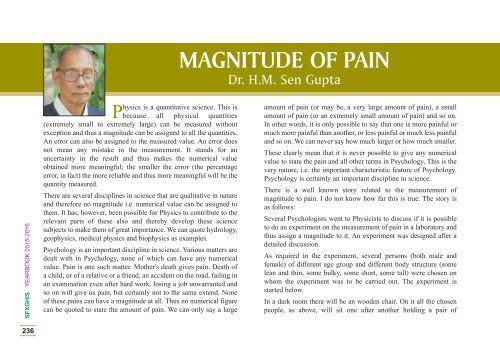Yearbook 2015-2016 _ Web version
Enjoy New School Book 2015_2016
Enjoy New School Book 2015_2016
Create successful ePaper yourself
Turn your PDF publications into a flip-book with our unique Google optimized e-Paper software.
MAGNITUDE OF PAIN<br />
Dr. H.M. Sen Gupta<br />
SFXGHIS YEARBOOK <strong>2015</strong>-<strong>2016</strong><br />
Physics is a quantitative science. This is<br />
because all physical quantities<br />
(extremely small to extremely large) can be measured without<br />
exception and thus a magnitude can be assigned to all the quantities.<br />
An error can also be assigned to the measured value. An error does<br />
not mean any mistake in the measurement. It stands for an<br />
uncertainty in the result and thus makes the numerical value<br />
obtained more meaningful; the smaller the error (the percentage<br />
error, in fact) the more reliable and thus more meaningful will be the<br />
quantity measured.<br />
There are several disciplines in science that are qualitative in nature<br />
and therefore no magnitude i.e. numerical value can be assigned to<br />
them. It has, however, been possible for Physics to contribute to the<br />
relevant parts of these also and thereby develop these science<br />
subjects to make them of great importance. We can quote hydrology,<br />
geophysics, medical physics and biophysics as examples.<br />
Psychology is an important discipline in science. Various matters are<br />
dealt with in Psychology, none of which can have any numerical<br />
value. Pain is one such matter. Mother's death gives pain. Death of<br />
a child, or of a relative or a friend, an accident on the road, failing in<br />
an examination even after hard work, losing a job unwarranted and<br />
so on will give us pain, but certainly not to the same extend. None<br />
of these pains can have a magnitude at all. Thus no numerical figure<br />
can be quoted to state the amount of pain. We can only say a large<br />
amount of pain (or may be, a very large amount of pain), a small<br />
amount of pain (or an extremely small amount of pain) and so on.<br />
In other words, it is only possible to say that one is more painful or<br />
much more painful than another, or less painful or much less painful<br />
and so on. We can never say how much larger or how much smaller.<br />
These clearly mean that it is never possible to give any numerical<br />
value to state the pain and all other terms in Psychology. This is the<br />
very nature, i.e. the important characteristic feature of Psychology.<br />
Psychology is certainly an important discipline in science.<br />
There is a well known story related to the measurement of<br />
magnitude to pain. I do not know how far this is true. The story is<br />
as follows:<br />
Several Psychologists went to Physicists to discuss if it is possible<br />
to do an experiment on the measurement of pain in a laboratory and<br />
thus assign a magnitude to it. An experiment was designed after a<br />
detailed discussion.<br />
As required in the experiment, several persons (both male and<br />
female) of different age group and different body structure (some<br />
lean and thin, some bulky, some short, some tall) were chosen on<br />
whom the experiment was to be carried out. The experiment is<br />
started below.<br />
In a dark room there will be an wooden chair. On it all the chosen<br />
people, as above, will sit one after another holding a pair of<br />
236



